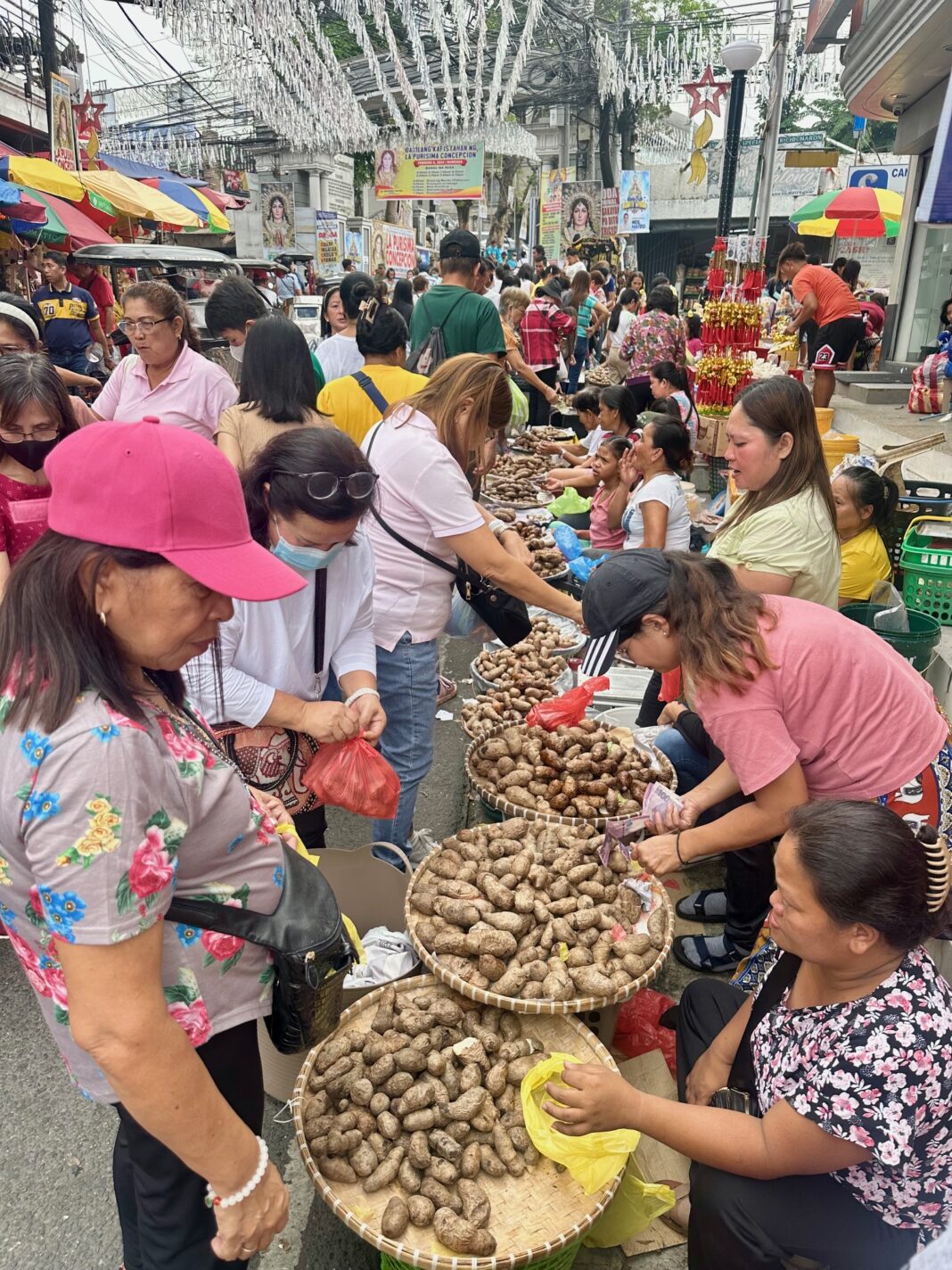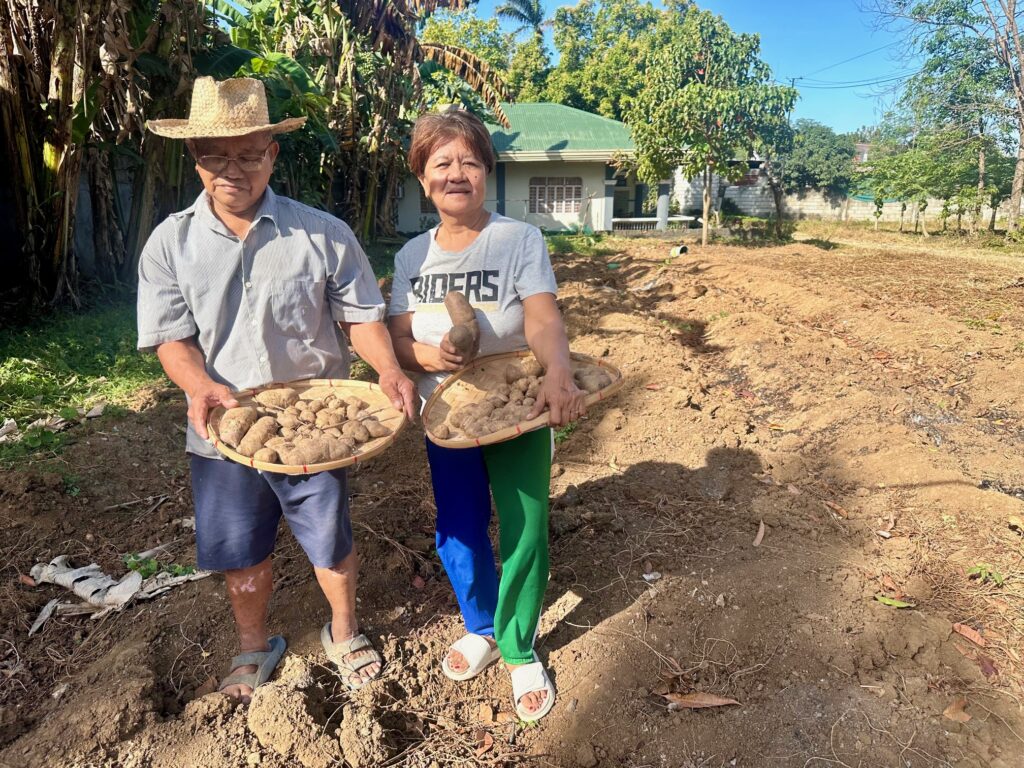
STA. MARIA, Bulacan—The distinct to this town once a year root crop, “tugi,” because of its cultural and religious significant being harvested only in time for the annual Feast of La Purisima Concepcion every second Thursday of February will continue to grow in the town’s soil amid seen scarcity over the years due to intervention and support of key officials and groups.
Municipal agriculture Arnel Garcia is now validating and conducting inventory of the number of farmers who continue to plant tugi in the villages of Balasing, Catmon, Bulac and Tumana in order to provide them the needed fertilizers to help them best produce their crop, the most sought food delicacy by the faithful and the tourists who come to the town on the Feast Day of La Purisima Concepcion.
Eighty four year old Prudencio Gravador, from Balasing, one of the local folks who still clings to planting tugi expressed concern the root crop is on its withering stage and will no longer be available for the the next generations to see and taste.
Tugi grows in the vast hilly lands in the villages of Balasing, Catmon, Bulac and Tumana. They were planted every May or June and harvested in December or last week of January in time for feast day. But, their supply has been scarce over the recent years due to land conversion and farmers getting old and dying.
Fertilizers and government subsidy
An orchard is needed to grow tugi, Mang Prudencsio said. Holes (lungao) should be made in the soil where the seed (harvested tugi) would be planted. Soil and fertilizer should be mixed to cover the holes. According to Mang Prudencio, organic fertilizer like palay husks, or dried leaves or cow or carabao manure are best fertilizers but they also need urea, but they are costly these days.
Garcia said tugi is planted every after the first rainfall or thunders in the month of May or June. When the leaves start to become green in the month of October, fertilizer could help the seedling grow bigger and faster and ready for harvest by the end of December to January.
Marlon Gravador, a barangay councilman in Balasing who is also a farmer and son of Mang Prudencio said a support from the municipal government to propagate the root crop by providing support fertilizers and other needs of the farmers can be a major boost to their backyard tugi industry.
According to Garcia, after the validation and inventory, they will immediately distribute the needed organic fertilizers for the May or June plantation of tugi.
Garcia said, because of the still available spacious backyards of Gravador family and other farmers who grow tugi, they are certain the once a year root crop will remain their town’s golden root crop every once a year and that’s why he said, the municipal government will do its part to keep tugi still planted and harvested every year.
“Dumadayo ang mga taga Maynila, taga Bocaue, taga Marilao, taga Meycauayan, taga Balagtas at mula pa sa iba’t ibang lugar at namimiyesta sa Sta Maria at dinadayo ang may tinda na tugI. Marami rin sa kanila ang kaya lang namimiyesta ay para lang sa tugue,” (People from Metro Manila, Bocaue, Marilao, Meycauayan, Balagtas and from other towns came during the feast day of Sta. Maria and many among them only come to the town just to buy tug,” says Mang Prudencio.
Similar to the taste of taro, tugue, which is simply boiled in water, is best served as merienda similar to sweet potato and taro. It can also be used for favourite Filipino dishes sinigang, pakbet and bulanglang, and others.
Jaime Corpuz, author of Bulacan’s heritage, culture and historical books and who owns the “Pamanang Bayan” museum in Marilao town said tugi grows only in the mountainous areas of Bulacan and Rizal, along the Sierra Madre mountain range. But in Sta. Maria, tugi has been the food symbolizing the people’s tradition and faith, he said.
“Nakaugalian na ng mga mamamayan ng Santa Maria at ng namimista sa bayang ito na bumili ng tugi at ipasalubong sa kanilang pamilya.Makikita itong nakalatag sa mga bilao na ibinenta sa labas ng simbahan sa panahon ng kapistahan ng bayan ng Santa Maria sa Bulacan. Hindi magiging ganap ang kapistahan ng La Purisima Concepcion sa unang Huwebes ng Pebrero matapos ang kapistahan ng Nuestra Señora de Candelaria kung wala kang makikitang nagtitinda nito sa kahabaan ng lansangan sa labas ng simbahan.Sa ganitong panahon ng kapistahan ng Santa Maria sa Bulacan ibinababa ang mga aning tugi mula sa kabundukan ng Montalban at Norzagaray na pawang nasa paanan ng suson-susong bundok ng Sierra Madre upang gawing tampok na paninda sa pista ng Santa Maria. Dito sinasamantala ng mga magtutugi ang kapistahang ito para ibida ang bungang-ugat na ito sa mga turistang nagyayao’t dili sa pamosong bayan ni Maria,” (It has been part of the tradition of the people of Sta. Maria and the tourists who come to the place during the feast day to but tugi for them and their families. These will be seen in billows and are lined up and sold along the street on front of the church. The Feast of the La Purisima Concepcion every first Thursday of February will not be complete without this root crop. During this feat day, the people from the mountainous areas in Sierra Madre come down to the town proper and sell their harvested tugi as the featured and most sought for food and delicacy of the town during the feast day in the town of Mary), says Corpuz.
Mang Prudencio only harvested 10 sacks of tugi last month compared to 20-30 sacks of the same month in the previous years because he could no longer plant in similar quantities because of his age and because of bigger capital required to buy and make organic fertilizers. At P1,600 per sack, he sold P16,000 for his 10 sacks. During the previous years, he sold each sack of tugi for P1,200. But, during his younger days or in the 1950’5 and the 1960s, per sack of tugi only cost even less than P20.00 per sack.
But, although he had aged, Mang Prudencio said he would not stop tilling the soil in his family’s backyard because planting and harvesting tugi is like keeping cash money in a piggy bank where he said he can stash a huge amount at a given time in a year. He sees the importance of propagating tugi today so that the root crop will continue to be harvested for the next generations to witness and taste.
“Sana ay may mga iba pang magtanim din bukod sa amin para mabuhay pa ang tugi at maabutan pa ng susunod na henerasyon. Mahina na ako ngayon, sa buwan ng Mayo ay 84 years old na ako. Konti na lang ang naitatanim ko. Pero kahit hindi na ganoong kadami ang naitatanim ko, tuloy tuloy pa rin ako at hindi humihinto sa pagtatanim ng tugi, kasi para bang isang alkansiya, pag ganoong panahon, mayroon akong kitang pera,” he said.
Gravador started planting tugi and different types of vegetables when he was 12. He learned it from his parents who were both farmers. He said his parents did not send him to school to help the family till their 7 hectares of farm.
During those days, he said, the only means of living of the people in Balasing, Catmon and for some in Bulac and Tumana were through farming, by planting rice crops, vegetables and tugue. “Palay, gulay at tugi lang ang uso noong araw dito, iyan ang kinabubihay ng tao, isa sa uri ng kabuhayan sa Balasing nong araw ang tugi ganoon din sa Bulac at Tumana, kinagisnan ng mga tao dito,” he told NEWS CORE at his farm on Tuesday (February 6).
Feast day blockbuster
For seventy year old Rhodora Sta. Ana, also from Balasing who both plant tugi in their family backyard and sells in front of the church of La Purisima Concepcion during the feast day, the story of tugi being associated with the patron dates back during the time of her grandparents and even beyond.
The story was that, in a plantation of tugi in Balasing, an image of the La Purisima Concepcion was found by farmers and residents. Since then, they plant and harvest tugi and sell them in the feast of La Purisima Concepcion.
Marietta Samonte from Barangay Catmon asked her daughter Jackelyn from Bulakan town to absent from her work to help her in selling tugi for the feast day on Tuesday. At P1,000 worth of capital each pail of 10 kilos, they will earn P4,000 for 5 pails during the eve and on the feast day itself at P120 a kilo of boiled and ready to eat tugi.
Lily Cristobal, 69, from Obando town said she regularly go to Sta. Maria during its feast day and she never forget to buy kilos of tugi for their family and her friends.
Pacita Mabun, 79, from Poblacion Sta. Maria brought home 2 kilos of tugi for her now 99 year old mother who is a devotee to La Purisima Concepcion.
According to Sta. Ana, the tradition and culture of the people of Sta. Maria of planting tugi will remain for generations. She said, only the people behind the tugi backyard industry perish over the years because of old age.
He said tugi will continue to grow in its vines in hectares of lands in Sta. Maria despite land conversion brought by economic growth in the town because the root crop can be planted in family backyards in Balasing, Catmon and Bulac and in other areas of Barangay Tumana.
Nerissa Cruz Del Rosario, tourism officer of Sta. Maria said the municipal government in partnership with different schools in the town are now conducting propagation programs for the root crop.
Tugi plantations in schools
Emer Jose, principal at Saint Mary Village in NorthVille Subdivision in Barangay Casio has been conducting propagation programs for tugi in the school campus since 2020.
He said students in Technology and Livelihood Education (TLE) and in Araling Panlipunan (AP) were given lectures about tugi because of its cultural and religious significance to Sta. Maria. He said, being an educator from the town, it was part of his obligation to help promote the rot crop which is distinct in his town.
He said, after a series of class discussions, application of the subjects of the lectures on tugi must be applied which prompted them to put up campus plantations and vines. While they started with a small plots, they will create bigger plots and plant more tugi in the coming school years.

Jose is also proposing to the Department of Education that tugi lectures and actual planting be part of the school curriculum in the town because of its significance to the cultural, religious and tradition of Sta. Maria.
In collaboration with Polytechnic University of the Philippines (PUP) in Sta. Maria, the students were able to make “tugi jam” similar to “ube jam” or “Ube halaya” and other sweet delicacies made of the root crop.
Propagation in other Bulacan towns
According to Garcia, there was a previously proposed plan for tugi to also be planted in similarly mountainous towns of Norzagaray, San Miguel, Dona Remedios Trinidad and San Ildefosno. But, he said this has yet to prosper.
Garcia has bought several kilos of tugi and made them as special tokens to fellow agriculture officers in the rest of the 19 towns and 4 cities in Bulacan for this year’s feast.
Garcia said it is also his way of helping promote their very unique root crop.
But, according to Gloria Carillo, Bulacan Provincial Agriculturist, tugi should be established as economically feasible or proven to have a sustained market even on a yearly harvest season.
But, Carillo said, the first thing that is needed is to intensify the production to sustain the large market requirement.






